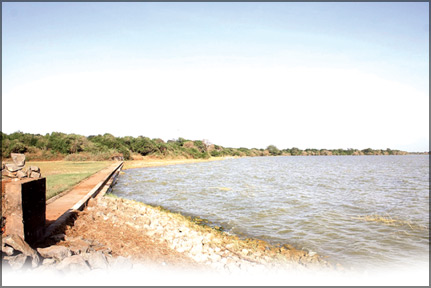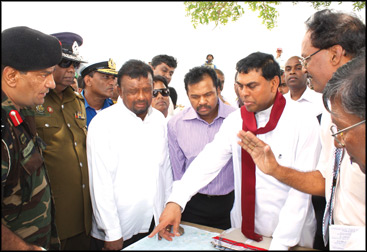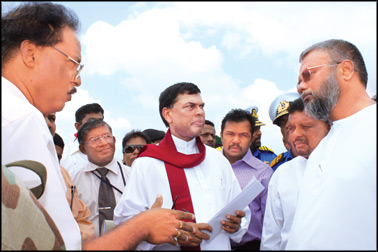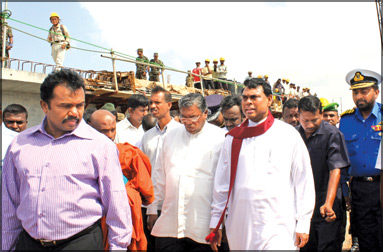|
Northern resettlement in full swing:
Mannar makes the first move
Dhaneshi Yatawara in Mannar
 |
|
“Yodha Wewa” Pic:
Thilak Perera |
Resettlement of the IDPs is the government’s prime concern. Along
with providing almost all the necessities of these people who got
displaced due to LTTE terrorists it is the utmost necessity to concern
over these peoples greatest hope of returning home.
No sooner the Security Forces liberated the original lands of these
people the Government machinery started rebuilding the areas making them
fit for habitation. As a result of hard work and dedication the North is
slowing getting resettled.
The resettlement of civilians displaced by LTTE atrocities in the
Northern Province was initiated last week at Savariapuram in the Musali
DS Division in Mannar.
The Resettlement and Disaster Relief Services Ministry together with
the line ministries and relevant Government Ministries strictly ensuring
that the people are provided with all the basic needs, resettled 122
families comprising over 400 people in their original properties.
‘First of the North’
Mannar district liberated from the LTTE mid last year was being
cleared of landmines and was the first region where civilians were being
resettled. Demining is being done in the other districts of the north
and progressively all displaced civilians would be resettled in their
original villages or towns.
Troops attached to the 58 Division of the Sri Lanka Army liberated
these areas in Mannar popularly known as the `Rice Bowl’ on June 29,
2008. They captured over 120 square kilometres of land and the
historical `Giants Tank’ (`Yodha Wewa’) which is around 23 square
kilometres in extent. The `Rice Bowl’ comprises approximately 153 major
and minor tanks and irrigation systems.
Extending further
 With this victorious task the Government was able to start the
foundation work of the resettlement process along with the demining
process. The Ministry of Nation Building initiated the ground work for
resettlement even when the war was continuing in the northern areas of
Mannar along with the demining work. With this victorious task the Government was able to start the
foundation work of the resettlement process along with the demining
process. The Ministry of Nation Building initiated the ground work for
resettlement even when the war was continuing in the northern areas of
Mannar along with the demining work.
Registration of the names of families that were to be resettled and
providing them with food and non-food essential necessities took place
during these initial stages.
Presently, demining is continuing in 15 divisions and in six division
the land is cleared of mines.
In addition to the physical resettlement of the displaced people of
the North, the Resettlement Ministry was providing the people with means
of livelihood development like providing tools for those engaged in
carpentry, masonry or motor mechanism or seed material and agricultural
implements for those who had cultivated paddy or other crops, Disaster
Relief and Resettlement Ministry sources said.
“The Northern resettlement programme will follow the Eastern
resettlement programme since the Government resettled more than 200,000
people in the East in a short span of time which was a true success to a
developing country like ours,” a Ministry official said.
The Government has provided funds for the people who return to their
villages, to repair and renovate their damaged homes. In addition to the
assistance to repair or rebuild their original homes, civil
administration had also been set up with Grama Nildharis who have been
appointed already and police stations set up in these areas.
 The massive historic irrigation scheme ‘Yodha Weva’ is also to be
rehabilitated at a cost of Rs. 380,000,000 provided by the World Bank
and the roads from Medawachchiya to Mannar would also be developed to
facilitate the people to bring their agricultural produce to the towns
for sale after the irrigation scheme was rehabilitated and cultivation
in this region restarts. The massive historic irrigation scheme ‘Yodha Weva’ is also to be
rehabilitated at a cost of Rs. 380,000,000 provided by the World Bank
and the roads from Medawachchiya to Mannar would also be developed to
facilitate the people to bring their agricultural produce to the towns
for sale after the irrigation scheme was rehabilitated and cultivation
in this region restarts.
According to District Secretariat office statistics in 2006, 19,685
families have been depending on the waters of the `Yodha Wewa’ with an
estimated 24,438 acres of arable land area.
The families in Musali who are coming back to their original places
of residence are to live in tents provided to them until their homes
were repaired and fit for habitation. Needs like cooking utensils will
also be provided to all families in the assistance package with
sanitation facilities as well.
For our own people
Officially commencing the resettlement activities in the North, the
second phase of the national resettlement programme, Senior Presidential
Advisor Basil Rajapaksa MP stressed that aid organizations, INGOs and
NGOs, should be honest in helping civilians who have fled from the
terrorists’ clutches.
Stating that the international agencies are engaged in a futile
attempt to create fissures among communities under the pretext of
assisting Sri Lanka the Government will not allow international
organizations to sow the seeds of disunity and division among
communities. The priority is meeting the needs of the people and not
personal agendas.
Mannar, in fact, was a significant city of the ancient Sri Lanka as
an important trading port apart from its worthiness for its most fertile
land and high yields of rice. According to historians who have
extensively researched on these ancient areas like Ellawala Medhananda
Thera, Mannar is a village located close to the greatest port of the
Western coast in the ancient times, the Mahathiththa.
 As per the historical records Mahathiththa continued as the chief
port of Rajarata at least up to the thirteenth century. It functioned as
an important trading point where South Indian traders flourished. As per the historical records Mahathiththa continued as the chief
port of Rajarata at least up to the thirteenth century. It functioned as
an important trading point where South Indian traders flourished.
Apart from its economic value, this areas is blessed with one of the
fertile lands in this island nation. According to statistics available
with the District Secretariat office, in the year 2006 the total Mannar
district recorded 47,958 metric tons of paddy harvest in maha season.
The Mannar district is capable of producing a massive yield of paddy
harvest and high quality seed paddy. When the people settle down again
and start their normal lives and livelihood activities, we will be able
to see wonders on this blessed land.
Hopefully in a short period we may see beautiful green paddy fields,
when the original owners of this patch of land resettle in these life
regaining lands.
Pix: Chaminda Hittetiya
|

